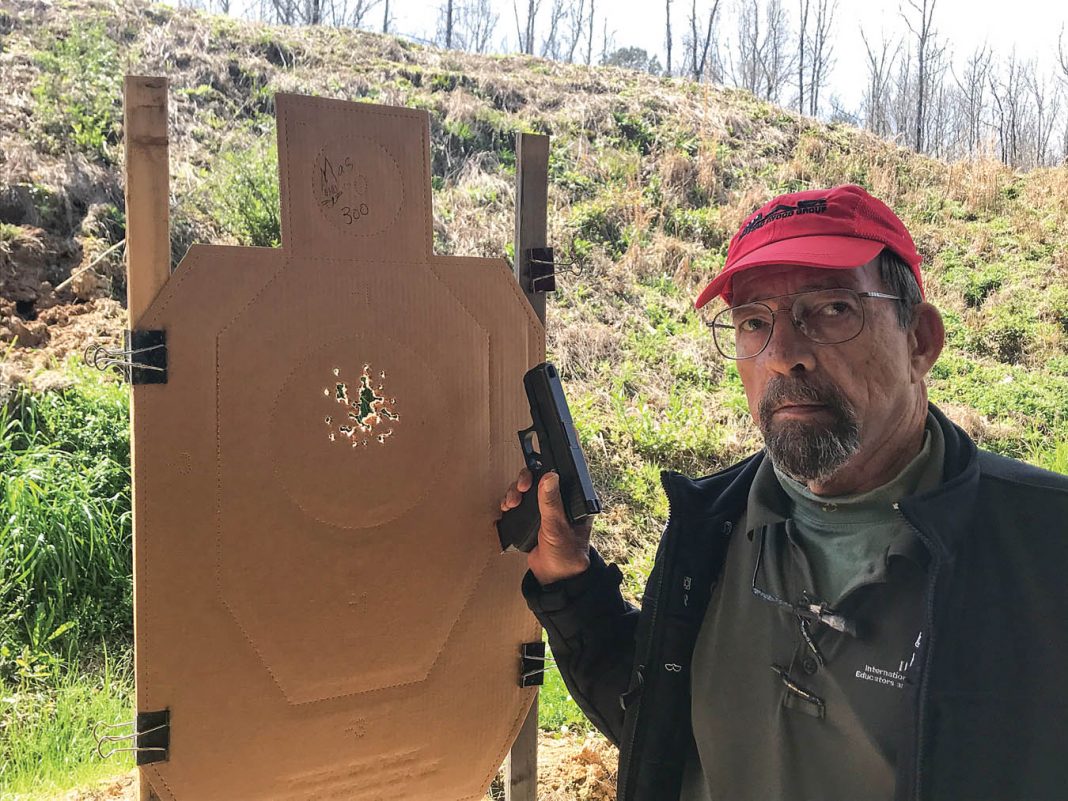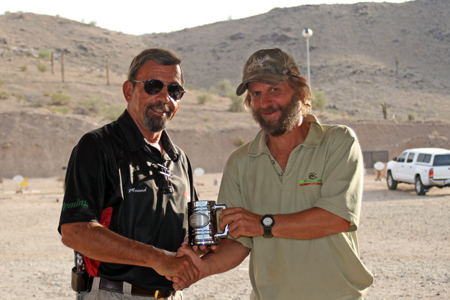Deer season is upon us. It’s a time to not just scout the woods, but to make sure the harvesting tool is ready to do its job. Is your huntin’ gun sighted in? If you’re using new ammo, you HAVE proven it out, right?
Why are these concepts in the forefront of my mind, you ask? Well, the last weekend in October I competed in the Georgia State IDPA championships using a proven-reliable Wilson Combat .45 pistol, and came in last in Master class, due in large part to loading from a new case of match-grade ammo that had just come in from a reputable commercial reloader. The test loads from the previous batch had worked flawlessly in the gun, but this new lot of ammunition apparently wasn’t crimped right. I stopped counting the jams at the ninth one. Not a good thing when your elapsed time is a key determinant to your final finish. “The Last Master” would make a cool title for a kung-fu movie, but trust me, it’s NOT where you want to finish in a shooting match.
The first weekend in November, I shot my final major tournament of the year, the South Mountain Regional IDPA Championship which was splendidly run by Bill Barron and his team at the Phoenix (Arizona) Rod & Gun Club. Prior to going, I selected my usual factory ammo out of a case I’d already worked with and knew was perfect. I was shooting Stock Service Revolver division this time, so I grabbed the first five four-inch barrel Smith & Wessons I found in the gun safe and took them to the practice range with the .38 Special +P ammo I knew I’d need to make the required power factor. A sweet, newly-acquired Model 19 grouped tight but way off center, and I didn’t have time to sight it in. A Model 15 that had given me First Master at the US East Coast Nationals last summer (beaten with that type of gun only by Craig Buckland, who was a few weeks out from winning the National Championship), didn’t seem as spot on now as then. An older Model 15 that had won a Regional for me in ’08 was close enough for consideration. A Model 64 that won the Midwest Regionals for me half a decade ago now seemed to be shooting off center. But my Model 686, tuned by Arkansas gunsmith Bob Lloyd, was shooting best of all, and three clicks left on its adjustable sight brought the tight group on the practice range dead center, so that’s the one that went into the suitcase.
To make a long story short, the gun and ammo worked perfectly, the bullets went where I aimed them, and I’m sitting here looking at a silvery trophy cup that declares me the Regional Champion in Stock Service Revolver division. Test-shooting and verification pay off! And, let me tell you, “Champion” feels WAY better than “Last.”
Moisture in the wood of your deer rifle’s stock may have warped it, causing pressure against the barrel that will change point of aim/point of impact coordinates from what they were last year. Something may have bumped your sights or your scope and knocked them out of alignment. Some subtle change in astigmatism in your own eyes may have occurred over time, which will affect your point of aim vis-à-vis point of impact. Something could have changed at the manufacturing end between the ammo you used last year and the new lot of the SEEMINGLY identical ammo you bought for this year.
The old adage is true: “Prior Planning and Preparation Prevent Piss-Poor Performance.”
And, by the way, kudos to Phoenix Rod & Gun Club for a challenging, efficiently-run, and shooter-friendly match.
But, hey, don’t take my word for it. I’m sure there are many stories the Backwoods Home blog readers can tell which will reinforce these lessons of knowing what your firearm will do, before you have to do something with it, the outcome of which is important to you. You’re all invited to share those experiences here, in “Comments,” below.
One stage at South Mountain made you a preacher behind a pulpit, who had to draw, take cover, and return fire on anti-religion zealots who opened fire. Care had to be taken not to hit the targets representing parishioners in the pews. Here S&W 686 tuned by Bob Lloyd clears Galco belt-slide holster from under EOTAC concealment vest.

The reward for having your gun & ammo squared away before you need to use them: Bill Barron, right, presents author with Regional Stock Service Revolver Champion cup. He and his crew ran a great match.




You definitely picked a great time to come to Phoenix :). The weather FINALLY just turned pleasant.
As an Arizona native, I have many fond memories of that Rod&Gun club from my high school and college years and wish I still lived in the area or could visit more often. The outstanding RO/Instructor known mainly as Coach Pat, though he passed a few years ago, was a great credit to the club and I hope today there are many others like him on the lanes helping shooters build skill and confidence like he did for me.
Anyway, I completely agree that there are “little anomalies” that can make your guns’ “perfect group” turn into a wild pattern- or worse- and that we should be constantly on guard for such an occurrence no matter how the gun or ammo worked last year. This is especially true for those of us who have so many guns that trial-shooting them ALL once a year can be a daunting challenge! =>
Mas,
This blog reminded me why when I go out shooting I like to confirm my zero with my AR.
The AR has become my truck and home defense gun. If I could, I would carry one on a Tac Sling when shopping, dating, oops I can’t do that anymore says the Mrs., and going about my daily life.
The handgun, which is marginal at best for defensive use in my opinion, is something that I use to fight my way back to the rifle, be it in the truck, or in my home while I am at the Mall. The role of the handgun is to allow you to fight your way back home, or to a better weapon. I keep better weapons at home, hence when I’m fighting my way to a better weapon I’m most often fighting to go home.
Take care and stay safe,
Biker
Congrats Mas! That mug looks like it’s ready to be filled with Guinness.
HECK YEA!
Nice shootin!
And great post, THANKS!
Mas! Your always the ‘First Master’!
Hugs
The strangest theme for a competition I’ve ever heard. Makes me uncomfortable, setting up that kind of confrontation. Plenty of other less inflammatory themes for our times, IMHO.
Steve
Congrats Mas! Oh, how I wish I had such a well stocked gun safe.
Is that gunpowder residue on the side of the pulpit ( lectern) ? Any photos of the “congregation” ?
Congrats on the win.
Steve, strange but actually closer to possible reality than other kinds of stages. It’s something someone DEFINITELY needs to consider and think about if he is a pastor and also carries…. how will he react if his church is stormed by men intent on slaughtering the flock he has been given spiritual charge over? Or maybe just a parishoner who carries in church. How will he react if the same situation happens. Considering all the innocents around him is a critical necessity, especially in a church setting where you personally know a good deal of those innocents. Inflammatory? Maybe, but it needs to be considered. Kudos on PRGC then.
Hi Mas,
Many years ago I shot an I.P.S.C. match in Indiana. I had not read the match write up or if I did it did not sink in. The match was the Cooper Assault. If my memory is right; you shot right and left barricade and then a couple from over the top, reholster, climb over the barricade, crawl through a tunnel, come out of the tunnel, draw the pistol weak hand and shoot a couple more targets.
Usually when shooting this match I used a different holster that I could draw weak hand. My normal holster was a Bianchi Askins Avenger behind my right hip, butt forward. Try as I might I could not draw weak hand with this holster, so I moved it to the front where I could get to it.
Now, this club’s president was an FBI agent that I new quite well. Just as I pulled up and parked he started his run. About half way through he dropped his piece and was disqualified. I gave him all kinds of good natured grief over his performance, about what they teach down there at Quantico,etc.
I should mention that this was in the winter with about 6 inches of snow on the ground and in the tunnel. Well, when it came to my turn, after I came out of the tunnel, I reached for my piece and it wasn’t there. It was laying back in the tunnel half hidden by snow. I could only sheepishly pick it up and explain that, look at least the safety is on. Of course, I was also disqualified and took my share of grief. In other words read the match write up and prepare. I still shiver, thinking about that weapon flipping out of the holster, the muzzle had to have crossed my body. We had a fellow in the club that would wear 2 holsters so that when reholstering he would put it in the weak holster. He moved to FL and you have probably shot with him.
On the subject of crimping the .45 acp: Bill Wilson’s Ellite, Tactical magazines have a flier included with the mags. It says when using H&G 200 gr. bullets the oal length should be 1.250″ and the taper crimp on the edge at .468″. I have checked factory loads and they are usually about that too except, that is with jacketed bullets. I think at .468″ with a cast bullet accuracy will suffer. If you figure that your brass is about .012″ thick, add .012″ + .012″ + .452 bullet dia. = .476. Squeezing that down to .468″ does not seem to be a good idea. Even if your brass is .010″ thick and your bullets are .451″ that is still .471″. I generally try for .470″. Lee makes a nifty crimping die that is easily adjustable with a carbide sizing ring incuded. If using mixed brass the lengths are probably uneven and the crimp will not be even. A long case can bulge when crimped. The Lee crimping die with the carbide sizing ring will iron out those bulges. I use the Lee crimper for .45 as well as the ugh 9mm. Of course for a big match it is always a good idea to take the barrel out and drop every round into the chamber and make sure it goes KlunK! I know some guys who will not use factory ammo for “serious social purposes” as it has been circulated that sometimes the flash hole does not get punched out!
Best,
Randy
Steve:
There have been several church shootings in recent years. In only one case was the shooter stopped before he hurt everyone he wanted. The exception was in Colorado where an armed church staff member put down a shooter who had already attacked people at another church.
The pulpit setup is too limiting. It would be more valuable to treat this as a situation with a few shooters (usually only one) mixed in with many innocent bystanders and victims. That way, it would apply to any armed defender in any crowd situation, not just a clergyman during a church service.